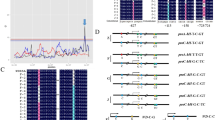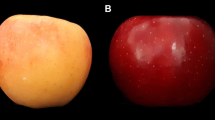Abstract
The FRUITFULL (FUL) and SHATTERPROOF (SHP) genes are involved in regulating fruit development and dehiscence in Arabidopsis. We tested the hypothesis that this class of genes are also involved in regulating the development of fleshy fruits, by exploring genetic and phenotypic variation within the apple (Malus domestica) gene pool. We isolated and characterised the genomic sequences of two candidate orthologous FUL-like genes, MdMADS2.1 and MdMADS2.2. These were mapped using the reference population ‘Prima x Fiesta’ to loci on Malus linkage groups LG14 and LG06, respectively. An additional MADS-box gene, MdMADS14, shares high amino acid identity with the Arabidopsis SHATTERPROOF1/2 genes and was mapped to Malus linkage group LG09. Association analysis between quantitative fruit flesh firmness estimates of ‘Prima x Fiesta’ progeny and the MdMADS2.1, MdMADS2.2 and MdMADS14 loci was carried out using a mixed model analysis of variance. This revealed a significant association (P < 0.01) between MdMADS2.1 and fruit flesh firmness. Further evidence for the association between MdMADS2.1 and fruit flesh firmness was obtained using a case–control population-based genetic association approach. For this, a polymorphic repeat, (AT)n, in the 3′ UTR of MdMADS2.1 was used as a locus-specific marker to screen 168 apple accessions for which historical assessments of fruit texture attributes were available. This analysis revealed a significant association between the MdMADS2.1 and fruit flesh firmness at both allelic (χ 2 = 34, df = 9, P < 0.001) and genotypic (χ 2 = 57, df = 32, P < 0.01) levels.



Similar content being viewed by others

References
Andersen JR, Schrag T, Melchinger AE, Zein I, Lubberstedt T (2005) Validation of Dwarf8 polymorphisms associated with flowering time in elite European inbred lines of maize (Zea mays L). Theor Appl Genet 111:206–217
Brem RB, Storey JD, Whittle J, Kruglyak L (2005) Genetic interactions between polymorphisms that affect gene expression in yeast. Nature 436:701–703
Breseghello F, Sorrells ME (2006) Association mapping of kernel size and milling quality in wheat (Triticum aestivum L) cultivars. Genetics 172(2):1165–1177
Carlborg O, Haley CS (2004) Epistasis: too often neglected in complex trait studies? Nat Rev Genet 5:618–625
Cordell HJ, Clayton DG (2005) Genetic association studies. Lancet 366:1121–1131
Costa F, Stella S, Van de Weg WE, Guerra W, Cecchinel M, Dallavia J, Koller B, Sansavini S (2005) Role of the genes Md-ACO1 and Md-ACS1 in ethylene production and shelf life of apple (Malus domestica Borkh). Euphytica 141:181–190
Costa F, Van de Weg WE, Stella S, Dondini L, Pratesi D, Musacchi S, Sansavini S (2008) Map position and functional allelic diversity of Md-Exp7, a new putative expansin gene associated with fruit softening in apple (Malus x domestica Borkh) and pear (Pyrus communis). Tree Genet Genomes 4(3):575–586
Dinneny JR, Yanofsky MF (2005) Drawing lines and borders: how the dehiscent fruit of Arabidopsis is patterned. BioEssays 27:42–49
Dirlewanger E, Graziano E, Joobeur T, Garriga-Caldere' F, Cosson P, Howad W, Arus P (2004) Comparative mapping and marker-assisted selection in Rosaceae fruit crops. Proc Natl Acad Sci USA 101:9891–9896
Doyle JJ, Doyle Jl (1990) Isolation of plant DNA from fresh tissue. Focus 12:13–15
Eriksson EM, Bovy A, Manning K, Harrison L, Andrews J, De Silva J, Tucker GA, Seymour GB (2004) Effect of the colorless non-ripening mutation on cell wall biochemistry and gene expression during tomato fruit development and ripening. Plant Physiol 136:4184–4197
Falush D, Stephens M, Pritchard JK (2003) Inference of population structure using multilocus genotype data: linked loci and correlated allele frequencies. Genetics 164(4):1567–1587
Ferrandiz C (2002) Regulation of fruit dehiscence in Arabidopsis. J Exp Bot 53:2031–2038
Ferrandiz C, Liljegren SJ, Yanofsky MF (2000) Negative regulation of the SHATTERPROOF genes by FRUITFULL during Arabidopsis fruit development. Science 289:436–438
Gupta PK, Rustgi S, Kulwal PL (2005) Linkage disequilibrium and association studies in higher plants: present status and future prospects. Plant Mol Biol 57:461–485
Hirschhorn JN, Daly MJ (2005) Genome-wide association studies for common diseases and complex traits. Nat Rev Genet 6:95–108
King GJ, Maliepaard C, Lynn JR, Alston FH, Durel CE, Evans KM, Griffon B, Laurens F, Manganaris AG, Schrevens E, Tartarini S, Verhaegh J (2000) Quantitative genetic analysis and comparison of physical and sensory descriptors relating to fruit flesh firmness in apple (Malus pumila Mill). Theor Appl Genet 100:1074–1084
King GJ, Lynn JR, Dover CJ, Evans KM (2001) Resolution of quantitative trait loci for mechanical measures accounting for genetic variation in fruit texture of apple (Malus pumila Mill). Theor Appl Genet 102:1227–1235
Knapp S (2002) Tobacco to tomatoes: a phylogenetic perspective on fruit diversity in the Solanaceae. J Exp Bot 53:2001–2022
Kosambi DD (1944) The estimation of map distances from recombination values. Ann Eugen 12:172–175
Krutovsky KV, Neale DB (2005) Nucleotide diversity and linkage disequilibrium in cold hardiness and wood quality related candidate genes in Douglas-fir. Genetics 171:2029–2041
Kulwal P, Kumar N, Kumar A, Gupta RK, Balyan HS, Gupta PK (2005) Gene networks in hexaploid wheat: interacting quantitative trait loci for grain protein content. Funct Integr Genomics 5:254–259
Li ZK, Pinson SRM, Park WD, Paterson AH, Stansel JW (1997) Epistasis for three yield components in rice Oryza sativa L. Genetics 145:453–465
Liebhard R, Kellerhals M, Pfammatter W, Jertmini M, Gessler C (2003) Mapping quantitative physiological traits in apple (Malus x domestica Borkh). Plant Mol Biol 52:511–526
Liljegren SJ, Ditta GS, Eshed Y, Savidge B, Bowman JL, Yanofsky MF (2000) SHATTERPROOF MADS-box genes control seed dispersal in Arabidopsis. Nature 404:766–770
Liljegren SJ, Roeder AH, Kempin SA, Gremski K, Ostergaard L, Guimil S, Reyes DK, Yanofsky MF (2004) Control of fruit patterning in Arabidopsis by INDEHISCENT. Cell 116:843–853
Litt A, Irish VF (2003) Duplication and diversification in the APETALA1/FRUITFULL floral homeotic gene lineage: implications for the evolution of floral development. Genetics 165:821–833
Liu J (2002) Powermarker—a powerful software for marker data analysis. North Carolina State University Bioinformatics Research Center Raleigh North Carolina (www.powermarker.net)
Mackay I, Powell W (2007) Methods for linkage disequilibrium mapping in crops. Trends Plant Sci 12(2):57–63
Maliepaard C, Alston FH, Van Arkel G, Brown LM et al (1998) Aligning male and female linkage maps of apple (Malus pumila Mill) using multi-allelic markers. Theor Appl Genet 97:60–73
Maliepaard C, Sillanpää MJ, van Ooijen JW, Jansen RC, Arjas E (2001) Bayesian versus frequentist analysis of multiple quantitative trait loci with an application to an outbred apple cross. Theor Appl Genet 103:1243–1253
Mei HW, Luo LJ, Ying CS, Wang YP, Yu XQ, Guo LB, Paterson AH, Li ZK (2003) Gene actions of QTLs affecting several agronomic traits resolved in a recombinant inbred rice population and two testcross populations. Theor Appl Genet 107:89–101
Neale DB, Savolainen O (2004) Association genetics of complex traits in conifers. Trends Plant Sci 9:325–330
Paran I, Zamir D (2003) Quantitative traits in plants: beyond the QTL. Trends Genet 19:303–306
Pinyopich A, Ditta GS, Savidge B, Liljegren SJ, Baumann E, Wisman E, Yanofsky MF (2003) Assessing the redundancy of MADS-box genes during carpel and ovule development. Nature 424:85–88
Pritchard JK, Stephens M, Donnelly P (2000) Inference of population structure using multilocus genotype data. Genetics 155:945–959
Quilot B, Wu BH, Kervella J, Genard M, Foulongne M, Moreau K (2004) QTL analysis of quality traits in an advanced backcross between Prunus persica cultivars and the wild relative species P davidiana. Theor Appl Genet 109:884–897
Rafalski JA (2002) Novel genetic mapping tools in plants: SNPs and LD-based approaches. Plant Sci 162:329–333
Risch NJ (2000) Searching for genetic determinants in the new millennium. Nature 405:847–856
Schadt EE, Lamb J, Yang X et al (2005) An integrative genomics approach to infer causal associations between gene expression and disease. Nat Genet 37:710–717
Seymour GB, Manning K, Eriksson EM, Popovich AH, King GJ (2002) Genetic identification and genomic organization of factors affecting fruit texture. J Exp Bot 53(377):2065–2071
Seymour GB, Poole M, Manning K, King GJ (2008) Genetics and epigenetics of fruit development and ripening. Curr Opin Plant Biol 11:58–63
Silfverberg-Dilworth E, Matasci CL, van de Weg WE et al (2006) Microsatellite markers spanning the apple (Malus x domestica Borkh) genome. Tree Genet Genomes 2:202–224
Silva C, Garcia-Mas J, Sanchez AM, Arus P, Oliveira MM (2005) Looking into flowering time in almond (Prunus dulcis (Mill) D A Webb): the candidate gene approach. Theor Appl Genet 110:959–968
Smith MWG (1971) National Apple Register of the United Kingdom. Ministry of Agriculture Fisheries and Food, Pinner
Sung SK, Yu GH, An G (1999) Characterization of MdMADS2, a member of the SQUAMOSA subfamily of genes, in apple. Plant Physiol 120:969–978
Tani E, Polidoros AN, Tsaftaris AS (2007) Characterization and expression analysis of FRUITFULL- and SHATTERPROOF-like genes from peach (Prunus persica) and their role in split-pit formation. Tree Physiol 27:649–659
Van Ooijen JW, Voorrips RE (2001) JoinMap® 30 Software for the calculation of genetic linkage maps. Plant Research International, Wageningen
Vinatzer BA, Zhang HB, Sansavini S (1998) Construction and characterization of a bacterial artificial chromosome library of apple. Theor Appl Genet 97:1183–1190
Vrebalov J, Ruezinsky D, Padmanabhan V, White R et al (2002) A MADS box gene necessary for fruit ripening at the tomato ripening inhibitor (Rin) locus. Science 296:343–346
Xing YZ, Tan YF, Hua JP, Sun XL, Xu CG, Zhang Q (2002) Characterization of the main effects, epistatic effects and their environmental interactions of QTLs on the genetic basis of yield traits in rice. Theor Appl Genet 105:248–257
Xu Y, Zhang L, RongCai MA (2008) Functional characterization and mapping of two MADS box genes from peach (Prunus persica). Chinese Sci Bull 53:853–859
Yu SB, Li JX, Xu CG, Tan YF, Gao YJ, Li XH, Zhang Q, Saghai Maroof MA (1997) Importance of epistasis as the genetic basis of heterosis in an elite rice hybrid. Proc Natl Acad Sci USA 94:9226–9231
Zhuang JY, Fan YY, Rao ZM, Wu JL, Xia YW, Zheng KL (2002) Analysis on additive effects and additive-by-additive epistatic effects of QTLs for yield traits in a recombinant inbred line population of rice. Theor Appl Genet 105:1137–1145
Acknowledgements
This project was carried out with the financial support from the UK Department for Environment, Food and Rural Affairs, and the Commission of the European Communities (contract N° QLK5-CT-2002-01492), Directorate-General Research-Quality of Life and Management of Living Resources Programme. We also would like to thank Plant Research International, Wageningen, The Netherlands, for making the reference population ‘Prima x Fiesta’ available to us.
Author information
Authors and Affiliations
Corresponding author
Additional information
Communicated by A. Dandekar
Electronic supplementary material
Below is the link to the electronic supplementary material.
Table S1
List of Malus domestica accessions used for the association mapping (XLS 45 kb)
Table S2
Microsatellite markers used to infer the population structure of the Malus accessions used for the association analysis (DOC 31 kb)
Supplementary Fig. 1
Bar plots of estimates of membership coefficient (Q) for each apple accessions analysed under admixture model, assuming uncorrelated allele frequencies (PPT 129 kb)
Rights and permissions
About this article
Cite this article
Cevik, V., Ryder, C.D., Popovich, A. et al. A FRUITFULL-like gene is associated with genetic variation for fruit flesh firmness in apple (Malus domestica Borkh.). Tree Genetics & Genomes 6, 271–279 (2010). https://doi.org/10.1007/s11295-009-0247-4
Received:
Revised:
Accepted:
Published:
Issue Date:
DOI: https://doi.org/10.1007/s11295-009-0247-4



